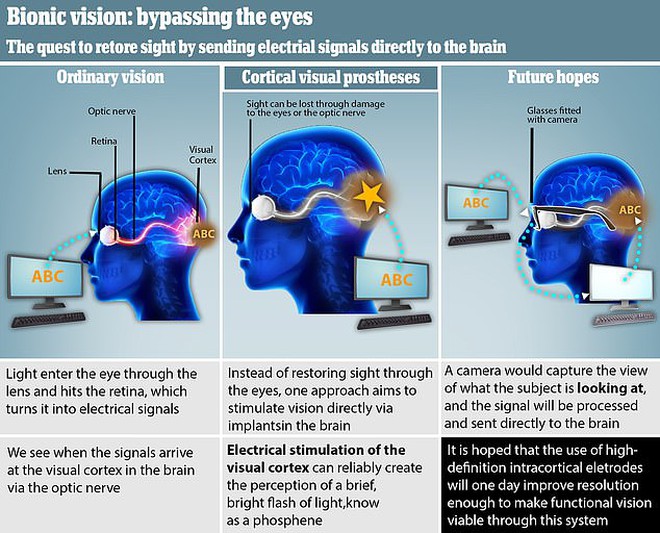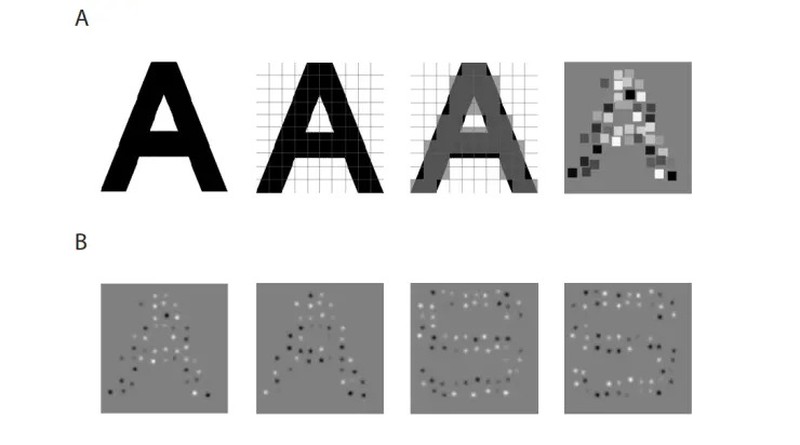The technique involves implanting electrodes in the monkeys’ brains to produce dots of light, according to a study published this week by experts in the Netherlands.
These dots, known as phosphenes, work in the same way as pixels on a television, each forming a small part of a bigger picture.
The patterns are still crude compared to real vision, and the technology has not yet been tested in humans, but is brings researchers a step closer to the eventual goal of allowing blind people to regain their sight.
The technology, developed by a team at the Netherlands Institute for Neuroscience (NIN), was published in the journal Science.

It builds on an idea first conceived decades ago: electrically stimulating the brain so it ‘sees’ via so-called phosphene dots.
Previous attempts to turn this theory into a reality had only limited success, mainly due to limitations of the technology available at the time.
NIN director Pieter Roelfsema developed implants consisting of 1,024 electrodes wired into the visual cortexes of two sighted monkeys.
‘Our implant interfaces directly with the brain, bypassing prior stages of visual processing via the eye or the optic nerve,’ explains Xing Chen, a postdoctoral researcher involved in the research.
‘Hence, in the future, such technology could be used for the restoration of low vision in blind people who have suffered injury or degeneration of the retina, eye, or optic nerve, but whose visual cortex remains intact.’

The visual cortex is located at the back of the brain and many of its features are common to humans and other primates.
‘The number of electrodes that we have implanted in the visual cortex, and the number of artificial pixels that we can generate to produce high-resolution artificial images, is unprecedented,’ said Dr Roelfsema.
This allowed the pair of monkeys to make out shapes like letters of the alphabet, lines and moving dots, which they’d previously been trained to respond to by moving their eyes in a particular direction to win a reward.
While the patterns are crude, they represent a significant advancement over previous implants, which allowed users to only determine vague areas of light and dark.
Dr Roelfsema said the ‘proof of principle’ study could one day be turned into a real device which could help some of the world’s 40 million blind people.
One possible mechanism could be a camera fitted to a pair of glasses and in-built AI to convert the scene into a pattern that is sent to the user’s brain.
Similar technology has appeared in works of science fiction, such as the visor device worn by Geordi La Forge on ‘Star Trek: The Next Generation.’
In a written commentary, Michael Beauchamp and Daniel Yoshor of the University of Pennsylvania hailed the breakthrough as a ‘technical tour de force.’

Dr Roelfsema said his team hopes to make similar devices for humans in about three years.
But the electrodes the team used require silicon needles that work for about a year before tissue builds up around the needles and they no longer function.
‘So we want to create new types of electrodes that are better accepted by the body,’ he said.
A wireless solution would be best, as it would mean the user wouldn’t need to wear an implant on the back of their skull, which requires scientists to operate and puts the user at risk of infection.
Fortunately, wireless devices that interface with the brain are advancing rapidly.
The prosthetics would only be suitable for people who once had sight and then lost it owing to disease or injury.
The brains of people who are born blind dedicate the visual cortex to other functions. But in people whose eyes stop working, the brain region remains idle, waiting for an input that never comes.














